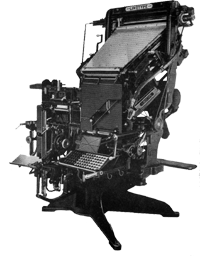
My Linotypes
The Linotype. 1884
What it is.
As the name implies, the Linotype is a machine that produces a solid "line of type." Introduced about 1886, it was used for generations by newspapers and general printers. It is a one-man machine: the operator sits in front with the copy to be set at the top of the keyboard. Having adjusted the machine for the required point size and line length, the metal heated to the correct temperature -- about 550 degrees Fahrenheit -- he commences setting.
A light press of the key buttons actuates a mechanism that releases the matrices. These are small pieces of brass in which the characters or dies are stamped. The matrices travel from the magazine channels where they are housed, by means of a miniature conveyor belt, into the assembler box. This assembler box is the composing stick of the Linotype. After each word the operator touches the spaceband key which allows a spaceband to fall before setting the first letter of the following word. These spacebands are steel wedges and are used to spread out the line of matrices to the required width. When these spacebands have entered the assembler they are so positioned that their minimum width is between the matrices.
When the assembler is nearly full of matrices, the operator must decide whether to send the line away for casting at the finished word; or, if the word is long and obviously will not come in the measure, just where to divide it. As these decisions are made very speedily, it is necessary for the operator to be expert in the correct dividing of words, otherwise corrections necessitating the re-setting of two or more new lines will have to be made at a later stage.
Justifying Spacebands
Having set the line of matrices and spacebands, the operator's function as regards the casting of the slug is practically finished. All that remains is for him to press a small lever and then move along to the next line.
When the operator presses the small lever at the right of the keyboard the matrices are taken automatically by the delivery carriage into the first elevator head, the latter descending to a position opposite the mold wheel through which the metal will flow. There the matrices and spacebands are justified to correct length of line. This is achieved by the justification block which pushes up the wedge-shaped spacebands until the matrices are spaced full out to measure.
The mold wheel moves forwards and the justified line of matrices forms a metal-tight joint exactly over the opening or mold in the mold wheel. Molten metal is then pumped in from the melting pot behind the mold, and the line is cast.
After the slug is cast, the mold wheel revolves, taking the mold with the slug from the horizontal casting position to the vertical ejecting position. During this movement the slug is trimmed at the foot so that it will be the correct type height.
The Linotype slug is not cast exactly to point dimensions as regards body size. On the front of the slug is a series of slightly projecting ribs. When the vertical ejecting position is reached, the slug is pushed out of the mold by means of the ejector blade, between the trimming knives, which trim the slug to an accurate body dimension, and finally the finished slug is delivered onto the galley.
But in the meantime, what of the matrices and spacebands? After the casting, they are taken first vertically by means of the first elevator and then laterally until the teeth of the matrices engage the ribs of a carrier bar attached to the second elevator lever. This lifts the line of matrices to the distributing mechanism at the top of the machine. The spacebands remain behind when the matrices are lifted to the distributor, and are brought back to their original position in the spaceband box, ready to be used again.
The distribution of the matrices to their correct channels in the magazine is one of the most interesting functions of the Linotype. The matrices have teeth in their upper ends so arranged that as they are propelled along the intermittent seven-ribbed steel distributor bar just above the open upper ends of the magazine channels, they become disengaged when over their correspoinding channels, and thereby fall into their correct places in the magazine, ready for further use.
Thus while the operator is assembling one line of matrices, a second is being cast, and a third line is being distributed back into the magazine. A magazine normally has 90 channels containing matrices, and each matrix carries two characters in any combination, although normally roman and italic are duplexed on the same matrix. Rarely used characters not contained in the magazine are inserted by hand in the assembler. After casting these are dropped off the distributor bar into a chute and finally come to rest in the "pi" box, also ready for use again.






























































